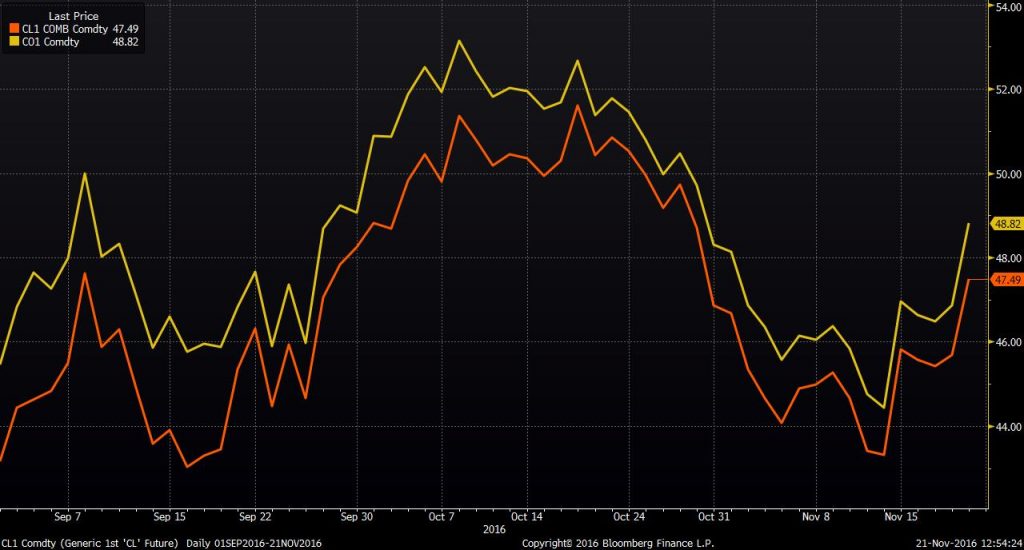Oil prices pushing markets higher
Oil prices rose to a three-week high Monday as investors continue to bet that OPEC will come to an agreement on production. While international crude oil benchmark Brent and U.S. benchmark WTI are still about 39% and 38% below their value on November 21, 2014 – a week prior to OPEC’s initial decision to defend market share instead of price – the upward trend in prices is pushing U.S. stock markets to a record peak.
Both crude benchmarks surged up over 4% today on news that Iran and Iraq appear to be ready to support a production cut inside OPEC. Previously, the two countries had been opposed cutting their own production as Iran looked to regain lost market share following the end of international sanctions, and Iraq lobbied for an exemption to help it fund its war against the Islamic State.
Saturday, Iranian Oil Minister Bijan Zangeneh said “it is highly likely that oil and energy ministers of the member countries of the Organization of the Petroleum Exporting Countries will reach an agreement” on November 30. Adding to positive market sentiment Sunday, Iraq Oil Minister Jabbar al-Luaibi said the country will offer three new proposals at meetings in Vienna this week, “all of [which] will be logical and in line with OPEC policy,” according to oil minister.
The news sent long contracts on crude oil at NYMEX to an all-time record-high of approximately 600,000, bolstering other markets. Among U.S. equities, the S&P energy index gained 1.9% as the top-performing sector, helping to push the benchmark S&P 500 index just shy of its intraday record of 2,193,81 set on Aug. 15, reports Reuters. The advance put the index on pace to set a closing high.
The Nasdaq hit an intraday record for a second day, reaching as high as 5,362.48, but market participants cautioned that volume was likely to be light this week ahead of Thanksgiving Day on Thursday.
The climb in oil lifted European markets as well, with the STOXX Europe oil & gas index up 2.2%, and Europe’s index of leading 300 shares .FTEU3 gaining 0.3%. MSCI’s all-country world index advanced 0.6%.
”It’s all adding up to where people are a little bit more bullish,” Donald Morton, senior vice president at Herbert J. Sims Co., told The Wall Street Journal. “Everybody wants to turn into a buyer.”
Analysts are also becoming more positive about a potential deal materializing. On Monday, Goldman Sachs raised the forecast for oil prices in the first half of 2017, given expectations that OPEC will announce and implement a production cut. A Bank of America Merrill Lynch research report also noted that a supply cut looks highly probable.
Record longs accompanied by record shorts
While many look forward to a deal that could raise prices to the $50 to $55 per barrel range two years after OPEC’s 2014 Thanksgiving Day decision sent prices tumbling, others in the market are more hesitant to say that they see a light at the end of the tunnel. Even Goldman Sachs’ cautioned “political risks can derail an otherwise economically sound decision.”
With the record number of long contracts on crude oil today came a rise in shorts to a new all-time high as well. Shorts on the commodity reached approximately 300,000 contracts at NYMEX as some get ready for the rug to be pulled out from under oil prices yet again.
“I am quite surprised to see oil moving higher – every time we get these discussions about OPEC agreements and production cuts, they always fall apart, nobody sticks to them – the oil cartel is very shaky,” said Randy Frederick, vice president of trading and derivatives for Charles Schwab.
“What ends up happening is you get people speculating, it pushes the prices up and then it ends up coming back down.”
“[OPEC’s] track record is horrendous,” said Mark Waggoner, president of Excel Futures. “Somebody makes another statement, things could change.”
Barclays expects the group will agree to a “face-saving statement,” in order to “showcase agreement, provide flexibility, and not veer too far from what countries had planned initially [for the first half of 2017].”
OPEC has left itself exposed to the market by saying repeatedly that the group will come to an agreement before the end of the month. The group’s members would suffer financially if they were unable to reach a deal during their next meeting on November 30, but any boost in price is likely to be met with an increase in U.S. production, effectively capping gains.
In September, members of OPEC said they would like to see oil prices in the $50 to $60 range. “There is no interest [in OPEC] to push crude oil prices” above that level, according to Swiss oil consultant Olivier Jakob, because an oil price above $60 would incentivize new shale production and prolong the supply glut.


